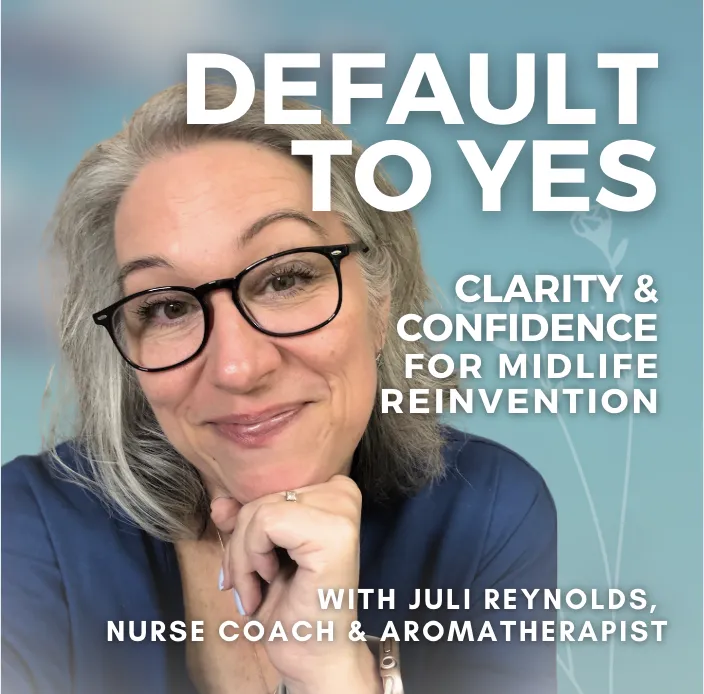Welcome to Default to YES! Podcast
your weekly coaching session for
clarity, confidence, and midlife reinvention.
SUBSCRIBE & NEVER MISS AN EPISODE!
OR GET ON THE LIST - I'll send you every episode along with all the bonus material!!

If you’re ready to move beyond surviving and start
saying YES—to your calling, to your health, and to your extraordinary self— If you are ready to train your brain
to cooperate with you - so you can get your goals and live a life that you love - this is for you!!
I'm Juli Reynolds, Board Certified Nurse Coach and Clinically Certified Aromatherapist Juli Reynolds, this podcast blends neuroscience, holistic health, and soul-centered coaching for leaders and high performers rise above burnout, navigate transitions, and live the life they were created for.
Each episode is approximately 20 minutes of:
Science-backed strategies for brain health, resilience, and well-being
Holistic practices like aromatherapy, breathwork, and lifestyle medicine
Stories & coaching questions that spark courage, confidence, and clarity in your daily life*

Blog
Default to Yes! Your Extraordinary Self

The Science of Peace as a Practice: Why We Lose Our Calm and How to Get It Back
By Juli Reynolds, RN, Nurse Coach & Founder of the Yes Society
“Come to Me, all you who are weary and burdened, and I will give you rest.
Take My yoke upon you and learn from Me, for I am gentle and humble in heart,
and you will find rest for your souls.
For My yoke is easy, and My burden is light.”
— Matthew 11:28–30
The Invitation to Peace
When Jesus said those words, He wasn’t talking to people on vacation.
He was talking to the weary — the overworked, the anxious, the overwhelmed.
He was offering something deeper than escape — alignment.
And that’s what peace truly is.
It’s not the absence of chaos; it’s the presence of calm in the middle of it.
It’s what happens when your nervous system, your thoughts, and your faith begin to move together again — in rhythm, not resistance.
The Science of Calm
Science now confirms what the soul has always known: peace begins in the body.
At the core of this connection is the vagus nerve — the longest nerve in the body, running from the brainstem through the heart, lungs, and gut.
When the vagus nerve is active, your body shifts from “fight or flight” into “rest and restore.”
Your breathing slows.
Your digestion improves.
Your heart rate steadies.
Your brain releases neurotransmitters that promote calm and clarity.
This is called vagal tone, and it’s measurable.
High vagal tone equals greater emotional resilience, faster recovery from stress, and higher levels of empathy and connection.
So yes — peace has physiology.
It’s a practice your body can learn.
When Peace Feels Far Away
I remember sitting in my car after long nursing shifts — the kind where your feet ache, your head spins, and your soul feels empty.
I’d put my hands on the steering wheel and just breathe.
At the time, I thought I was just trying to catch my breath.
But looking back, I realize: I was retraining my brain.
Peace doesn’t come when life finally gets quiet.
Peace comes when you learn to stay present in the noise — to regulate your body so your spirit can rise above the chaos.
It starts with the smallest of choices: one slow breath.
One prayer.
One drop of oil.
How Essential Oils Train the Brain for Peace
Our sense of smell is the only one directly wired to the limbic system — the emotional center of the brain.
That means scent bypasses logic and memory; it goes straight to emotion and behavior.
When you inhale an essential oil like bergamot, frankincense, or cedarwood, it activates receptors that communicate safety to the nervous system.
Bergamot, for example, has been shown to reduce cortisol and balance dopamine — helping restore a sense of well-being and hope.
That’s what I call Aromacognition — using scent to shape thought and mood intentionally.
In those moments of overwhelm, I’d roll cedarwood on my wrists, breathe deeply, and whisper,
“Lord, help me rest in You.”
And I could feel the shift.
My shoulders softened. My thoughts slowed. My heart caught up with my breath.
That’s the power of pairing science with Spirit.
Resignation vs. Restoration
We live in a world that teaches resignation:
“You can’t fix it.”
“It’s too hard.”
“It doesn’t matter.”
That mindset is sneaky — it feels like peace because you stop feeling.
But it’s really just numbness.
True peace doesn’t turn away from the world.
It turns toward it — calm, curious, and courageous enough to care.
When your nervous system is regulated, your perspective expands.
You start to see what you can influence, not just what you can’t control.
You notice moments of meaning — and invitations to contribute that you would’ve missed in survival mode.
That’s what Jesus meant by a “light burden.”
It’s not about easy circumstances — it’s about walking in partnership, not pressure.
Three Ways to Practice the Science of Peace
Breathe with Intention
Try the 4-7-8 breath: inhale for 4, hold for 7, exhale for 8.
Repeat three times. Feel your body remember what safety feels like.Anchor with Aroma
Apply or diffuse oils like bergamot, cedarwood, or frankincense during prayer, journaling, or quiet reflection.
Let the scent become a signal to your body: I am safe. I am centered. I am supported.Return with Awareness
Instead of escaping the world, engage it with intention.
Ask yourself, Where can I bring peace today?
Sometimes that’s in your home. Sometimes it’s in your workplace. Sometimes it’s just in your own thoughts.
From Overwhelmed to Open
When you train your brain and body for calm, you don’t lose your passion — you gain perspective.
You become the kind of person who carries peace into chaos.
You stop reacting and start responding.
You remember Who walks with you.
That’s the science of peace — and the sacred practice of it.
Because when Jesus said His yoke is easy and His burden is light,
He wasn’t promising a life without pressure.
He was offering a way to walk through it without losing your center.
Take the Next Step
If you’re ready to move from stress to stillness — to experience what peace feels like in your body, not just your mind —
Join me for the Peace in Motion Challenge.
It’s a week of guided breathwork, Aromacognition, and heart-centered practices to help you retrain your nervous system for calm.
Because peace isn’t something you find once.
It’s something you practice daily — with every breath, every thought, every yes.
👉 [Join the Peace in Motion Challenge Here]
Episode Resources and Freebies:
COMPANY
CUSTOMER CARE
NEWS
LEGAL

© Copyright 2025. Reimagine Wellness. All Rights Reserved.









